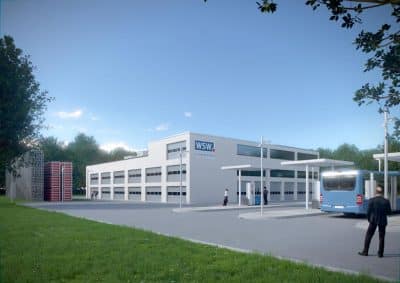Fuel cell buses have many advantages over their diesel counterparts, making them an attractive option for mass transit companies. A few examples are the complete absence of local emissions, the greater flexibility in choosing a primary energy carrier and, depending on the source of the hydrogen and the use of renewables, considerable potential for reducing carbon dioxide levels.
The many years spent on research and development and extensive trial periods in demonstration projects such as CUTE, HyFleet:CUTE, CHIC and HyTransit have turned up several holes in our knowledge about large-scale bus refueling. To fill in these gaps, the Fuel Cells and Hydrogen Joint Undertaking launched NewBusFuel, a project focused solely on the design of the relevant infrastructure.
Filling up buses is different from refueling cars. Not only do they need greater quantities and storage capacity, but they also require highly reliable and spacious installations, especially in urban areas, where most bus garages offer little room for additional equipment.
For a comprehensive analysis of infrastructure requirements and technological solutions, 13 teams made up of bus operators, hydrogen technology suppliers and other stakeholders channeled their activities during NewBusFuel to devise a plan for each of the 12 partner cities from 7 countries (see fig. 2).
…
The result was a wide variety of technology choices, from on-site production through electrolysis (see fig. 1) and steam reforming to near-site and off-site methods. Approaches ranged from pipeline use to the delivery of compressed and cryogenic hydrogen (see fig. 3).
…
Subsequent interviews provided opportunities to smooth out the details of the solutions offered, avoid stumbling blocks and give timely feedback on practicality. This feedback was later turned into a number of recommendations for the targeted and efficient implementation of hydrogen infrastructures (see [2]).
Requirements and settings may contrast sharply from region to region, which means that the findings should be considered goalposts and not definite targets for real-word application. Nevertheless, they offer robust estimates for any kind of hydrogen station as early as the conceptual stage. More data will have to be gathered by studying each scenario individually.
…
The cost of hydrogen
A second objective of the project was to calculate hydrogen costs at the fuel pump, including their share in the construction and operation of the equipment. The authors of each case study had set their own cost targets, typically based on diesel use cases, which came to EUR 4 to EUR 6 per kilogram.
In three of those, the employment of several technologies led to estimates matching outcomes. Three other solutions resulted in EUR 6 to EUR 8 per kilogram of hydrogen, while the total cost in the remaining studies far exceeded cost limitations. To respect the confidential nature of the information, this article will refrain from listing which stations did or did not meet expectations.
Recommendations
Success or failure notwithstanding, all comparisons, and all methods used to optimize cost effectiveness proved useful for providing guidance on how to achieve cost reductions in hydrogen bus refueling (see [1]).
For example, some bus operators were not used to such a close alignment of infrastructures and fleets. This alignment, however, is vital for preventing or limiting excess capacity and keeping down costs. Likewise, changes needed to be made to the strategies for guaranteeing supply. One example is the recommendation that spare parts critical to operation be held in store. Additionally, contracts should state service response times, and modular systems could provide redundant capabilities. Whereas bus operators aimed for relatively high storage capacity early in the project, figures were, in most cases, later lowered, not least because of cost and space constraints.
Similar recommendations have been devised for technology suppliers in the hydrogen industry, for example, to improve the reliability and efficiency of their components.
…
Other factors, such as European and national rules, were analyzed in conjunction with their impact on a country’s infrastructure costs. For example, the stringent regulations on safety distance and the placement of firewalls between components had increased the total cost of the concept system in Italy by around EUR 500,000.
Conclusion
NewBusFuel has shown that hydrogen can be an economically viable and competitive option, depending on the design of the supply infrastructure. But, of course, hydrogen is not diesel. One may not need a reminder, but it is important to point out the drawbacks and benefits of the gas. They are crucial to arriving at a technologically and economically sensible solution, which is required not only when building vehicles, but also – or even more so – when designing new infrastructures. The more hydrogen a system will consume, the earlier it will pay off, for example, when using redundant capabilities to achieve synergies and distribute the work. Hydrogen is an ideal candidate for powering zero-emission buses that need to travel medium to long distances. In turn, the buses can become a secure and reliable source of large-volume sales.
Economic viability can be improved further through strict adherence to development and research cost targets, e.g., as part of NIP 2 and FCH2 JU. Recently, Ballard and Solaris had announced that they would offer buses at EUR 450,000 under certain conditions, namely acquiring more than 100 of the 12-meter-long vehicles. Their running costs of EUR 5 per kilogram of H2, consumption of 7 kilograms per 100 kilometers, or per 62 miles, and an additional EUR 0.35 for each kilometer are merely 12 percent above the ones for conventional diesel buses and are fast approaching their levels [3].
…
Written by: Dr. Benjamin Reuter, Dr. Michael Faltenbacher, both for thinkstep AG, Leinfelden-Echterdingen, Germany



























0 Comments